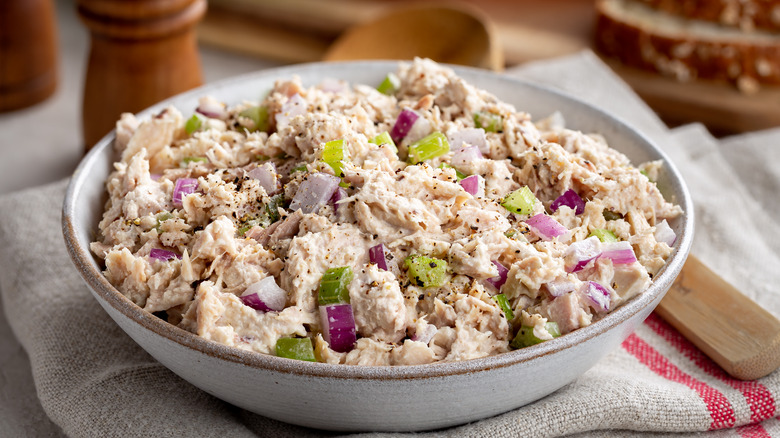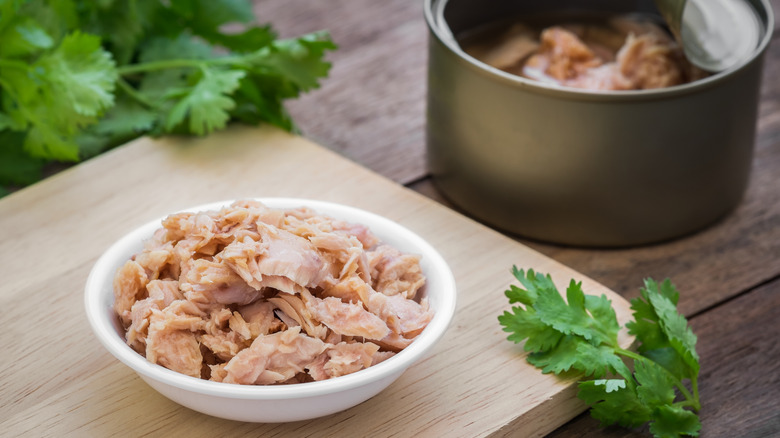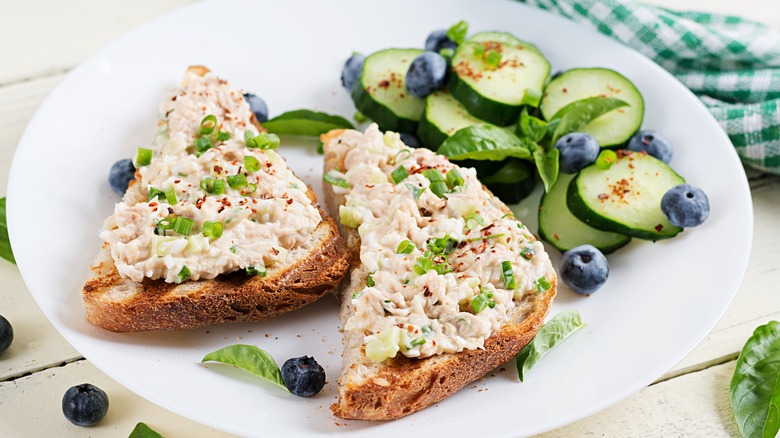Mushy Tuna Salad Is Gross. Here's How To Avoid It Every Time
A protein-rich amalgamation teeming with delicate ocean flavor and crunchy vegetables tied together with rich, decadent mayonnaise, tuna salad is a timeless dish that's equal parts delicious and nutritious. Despite the tedious chopping, preparing a tuna salad is relatively laid-back. But just because it's simple to make, doesn't mean it's impossible to mess up. One of the most common consequences of a tuna salad snafu is a batch that's far too mushy to enjoy. However, there's an elementary hack for avoiding squashy tuna salad altogether — gradually adding the mayonnaise.
When making tuna salad, the order of operations is essential. Adding the tuna to your bowl first and foremost allows you to visualize the quantity of the other ingredients needed, ensuring a balanced and well-proportioned dish. Once you've perfected your preferred tuna-to-veggie ratio and added a dash of citrus juice, it's time to bring out the mayonnaise. To begin, introduce a humble tablespoon of mayo to the bowl. Though it might not look substantial enough at first, you can't properly tell until you thoroughly mix it in, so don't cheat yourself on blending it. Continue the process with small amounts of mayonnaise until the salad is lush yet still structured and firm. If you notice pockets of milky liquid pooling in the mixture, you've gone too far with the mayonnaise.
Additional tips for preventing mushy tuna salad
Slowly and gradually introducing mayonnaise into your tuna salad is the easiest way to prevent a soggy, sloppy mess of a meal. However, there are some additional tips worth keeping in mind for extra insurance.
For starters, thoroughly drain your tuna can before adding it to a bowl. Open the can, but don't throw out the top. Secure the lid with your finger, leaving a small gap, and slowly pour out the liquid until the can is fully drained, putting pressure on the lid to get every last drop. Because water is more fluid, choosing tuna preserved in richer olive oil can help prevent a water-logged tuna salad.
Once you've mastered the perfect tuna salad ratios, jot them down for future reference. Premeasuring your ingredients instead of eye-balling them will ensure that you have a perfect seafood salad every time. If you can, always serve your tuna salad right away. The longer it sits in those must-have creamy ingredients, the more likely it is to become too mushy. If you're preparing tuna salad for a beach day or lunch at the office, consider bringing a shelf-stable packet of mayonnaise with you to add just before you eat.
Remedying a too-mushy tuna salad
Preventative measures are the safest way to achieve a perfectly-textured tuna salad. Sometimes, however, we make mistakes (and that's okay!). If you find yourself with a mushy tuna salad, don't just throw it out — there are a few practical solutions for reviving it.
The easiest way to absorb excess moisture is by introducing more ingredients. Starchy foods like potatoes and pasta can soak up the liquid and stabilize its consistency. Similarly, leftover rice can bulk up your tuna salad while simultaneously improving its quality. Consider serving tuna salad on two slices of toasted bread. The crusty toast can absorb those unappetizing juices while providing a much-needed textural contrast with its delicate crunch. If your mushy tuna salad is too far gone, transform it into a meal of tuna fish cakes by introducing breadcrumbs, eggs, and the seasonings of your choice before molding them into round, patty shapes and cooking them in the oven.
Because they're too delicious to waste, tuna salads deserve to be made with care. Introduce your mayo slowly, and you'll never have to worry about an ill-textured batch. And if you do make a mistake, take the time to remedy it. Did we mention that these preventative and remedying hacks also work with chicken salad and other mayo-based medleys?


